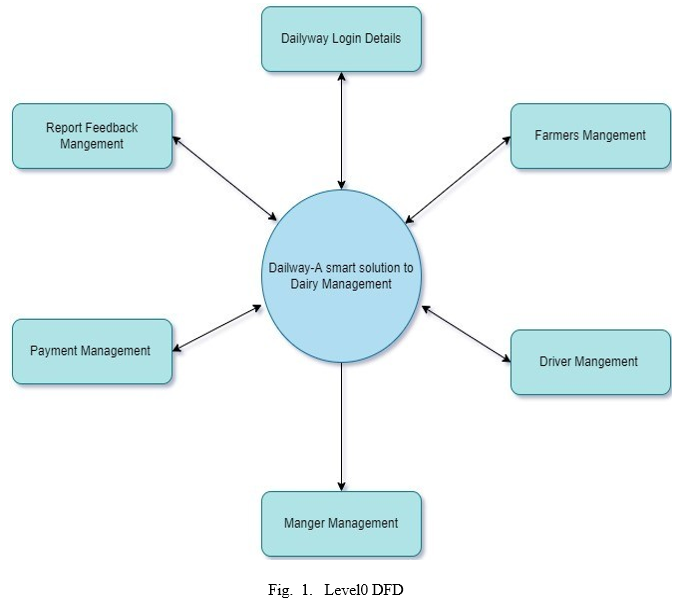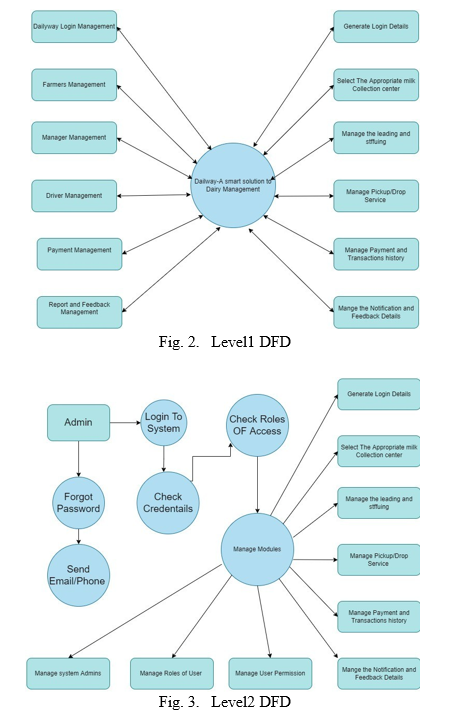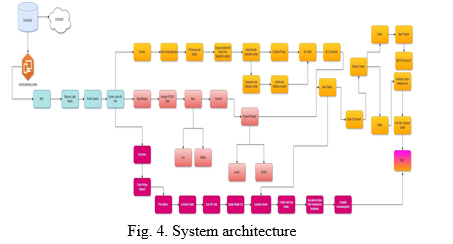Ijraset Journal For Research in Applied Science and Engineering Technology
- Home / Ijraset
- On This Page
- Abstract
- Introduction
- Conclusion
- References
- Copyright
DailyWay - Smart Dairy Management Solution
Authors: Sarvesh Vishnu Lahare, Akash Laxman Mahajan, Unnati Pankaj Gothi, Vaishnavi Chetan Patil, Prof. Swati R. Khokale
DOI Link: https://doi.org/10.22214/ijraset.2022.42698
Certificate: View Certificate
Abstract
Smart dairy farming is becoming more possible because of data-driven approaches. Due to the world’s growing population, the demand for milk is steadily increasing. In industrialized nations, such as the United States, dairy consumption is higher than in developing ones like India. Better technical approaches for enhancing milk transportation and financial flexibility are necessary to fulfil this rising demand for milk products. The usage of IOT and AI technology is predicted to aid a farmer in overcoming many conventional agricultural problems, which will be made easier for them by employing this approach. We are tackling the various problems that a dairy farmer faces on a regular basis in this project. The innovation in the transportation and milk collection of smart dairy farming is highlighted in a quick introduction to integrated smart solutions for dairy farming. This project focuses on many elements of smart dairy farming, culminating in the proposal of a state-of-the-art framework that may aid farmers in easing milk transportation by utilizing various cutting-edge technology. With limited resources, these technological approaches can have a detrimental impact on milk production while also increasing those that have a favorable impact.
Introduction
I. INTRODUCTION
The dairy business is a long-standing enterprise that we are all familiar with. Dairying is viewed as a tool for social and economic development in India. Millions of small pro- ducers, marginal land-holding farmers, and landless labourers supply the nation’s milk supply, which accounts for around 70“Smart dairy farming is linked to innovations in produced milk transportation and the dairy farming process.” “Dairy farmers are at the cutting edge of farming technology.” “This innovative approach will make it easier for individuals to sell and purchase milk at a reasonable rate without incurring transportation costs.” In the following decades, the Indian dairy sector is expected to develop dramatically.
The increase in milk consumption was fuelled by population expansion, urbanisation, income growth, high-income elasticity of demand, and changes in eating preferences, yet we are still lagging behind other nations due to our old customs. It’s past time to transform the dairy business into a smart, interconnected industry that benefits everyone. The ”DailyWay - A Smart Solution to Dairy Farming” will provide small farmers and workers who are still working hard in a world with full technology a new lease on life. Dairy producers face several restrictions in today’s economic environment, including herd management, fixed production capacity, and high-cost farm labour. With these restrictions and obstacles, a dairy farmer may make things simpler by employing a mobile-based application system for transportation.
A. The Motivation Behind The Project
India is recognised as a country of agricultural land, with agriculture providing a living for 75 percent of the population. They had to put in a lot of effort to earn their capital, which is very little in comparison to other industries. So the question that comes to mind is: Why can’t we turn their ”hard work” into ”smart work”?
One of our coworkers, who was travelling through the toll booth, saw the new rapid tag system and suggested that we adopt a similar approach, but in a different way, to make things easier and faster for small businesses like farming. Then he discussed with us his concept for applying IOT in the dairy business, which would benefit small-scale industries like farming and will lead to an integrated smart solution to dairy farming in India, which is still using conventional techniques from transportation to working without much technology.
The desire to help our nation by applying innovative technology and eliminating hard labour has led us to this initiative, which will take the dairy sector and farming to a new level of success. As young people, we see it as our responsibility to help others in rural areas who are uninformed of technological advancements.
B. The Project’s Goal And Objectives
This project seeks to make the world a better place for farmers who are ignorant of technology that will decrease their effort by combining transportation, billing, and appropriate administration into a single app on their smartphone. The project’s major goal is to transform India’s dairy farming sector into a smart dairy farming industry.
Project objectives:
- To create a dairy farming system that is both integrated and smart.
- To provide a simple and easy-to-use interface.
- To help the dairy farming sector save time
- To make it easier for farmers to pick up and drop off milk kettles by easing the transportation system.
- To provide a payment solution that is flexible.
- To give the appropriate amount of money based on the fat content of the milk.
- To raise awareness of new technology among individuals such as farmers, workers, and daily wage merchants.
II. LITERATURE SURVEY
A. Growth of The Dairy Farming Industry
Dairy farming has become an essential supplementary source of income for millions of rural households, and it has played a critical role in producing jobs and revenue.” “The method is unusual in that it involves around 120 million rural families in milk production, as opposed to large specialised dairy farmers in the west. Attempts have been undertaken to supply nutritious milk to urban consumers since 1947, when India achieved independence. To fulfil the demand, a significant number of dairies, primarily under government supervision, were put up one by one in metropolitan areas. There was no plan in place to supplement supply. During the lean production season, serious issues in the form of raw milk scarcity arose. Short-term solutions were implemented without considering the overall supply-demand system. This resulted in further issues. “India, with 146 million tonnes of total milk output, has been the world’s largest milk-producing country for the past decade, accounting for roughly 18.5 percent of global milk production in 2015-16.” “The value of milk group production is the largest among all agricultural commodities, accounting for approximately one-fourth of the value of output from the agricultural sector, indicating the importance of dairy enterprise in the national economy.” “Dairy farming is one of the most significant sources of income and nourishment for the rural population.” “Milk output has risen, bringing per capital milk availability to 250 grammes per day.” “In India, demand for milk and milk products is expected to rise to 142.9 million tonnes in 2015 and 191.3 million tonnes in 2020.” “If milk production continues at its current rate, supply will fall short of demand in the next ten years.” The success of India’s dairy industry has been outstanding. In India, milk output grew from 17 million tonnes in 1950-51 to around 146.3 million tonnes in 2014-15. Milk production has increased at a pace of approximately 5% per year over the last 15 years (2000-2015), compared to a global growth rate of 1.5 percent. “Dairy product exports grew from Rs. 13.98 million tonnes in 1990-91 to Rs.66,424.34 million tonnes in 2014-15.” “India is currently the world’s second-largest milk production, after only the United States.” India has made great progress in the field of dairy development during the last five decades. The country’s performance in terms of milk production, as well as annual growth in output, has been outstanding. It is generally known that dairying, more than any other sector of the Indian economy, has benefited the poor the most.
B. Smart Dairy Farming
Milk demand is expected to rise gradually over the next twenty years as low-income rural and urban households with larger expenditure snaps improve their financial gain as a result of the new economic environment. According to earlier surveys, rich nations consume more agricultural and dairy products than developing countries; nevertheless, this disparity is growing as the global population grows and diets change. Small farmers produce over 80% of the dairy in developing na- tions. These small farmers and family farmers are disconnected from technology and rely on traditional farming to meet the world’s increased demand; nonetheless, the use of technology on this platform remains necessary.
Smart dairy farming (SDF) is a vital concept for fulfilling the increasing demand for high-quality dairy products. Since 2015, milk has been the most in demand product, with significant price fluctuations. In order to compete in the global market, the Indian dairy industry must increase its production through the use of the Internet of Things. The Internet of Things has had an impact on milk production. This step is necessary in order to meet the dairy demand of a big percentage of the world’s population. We are approaching the end of the period in which milk demands can be fulfilled without the use of cutting-edge technology; after that, fulfilling demand for dairy and dairy products would be impossible without it.
C. Existing systems
- Meri Dairy
a. Daily input with Morning and Evening Shift SNF/FAT or set rate.
b. It is simple to look for a customer without the customer Id.
c. A record of milk sales and purchases.
d. View all of a customer’s transactions.
e. Bhugtan Register digital signature.
f. No more paperwork; everything is in your pocket.

2. Dairy Management System
Dairy Management software is an Android application that assists with day-to-day operations in dairies. It in- cludes the following information: Milk receipts are issued twice a day, in the morning and evening, with slips printed for farmers. Slips may be produced using either a Dot Matrix or a Laser-Jet printer. Milk sales to large dairy farms in communities. Credit and cash sales of livestock feed and other items to farmers and others. Prepare milk purchase bills from 1 above on a weekly/10- day/random basis. This milk purchase bill includes the option to print a ledger of additional transactions (cash payment/receipt/credit sales, etc.) that occurred within the billing period. Purchase of agricultural products for resale to farmers (cattle feed and other articles). Profit and loss statement, balance sheet, cashbook, bank book, journal, profit and loss statement, balance sheet, and so on. English, Marathi, Hindi, Gujarati, and other customised languages were supported. SNF computed from CLR using various algorithms or direct SNF inputs are also permitted. The rate can be automatically loaded from an excel file. DEGREE-only or Fat/SNF-only charts may be saved and created. Separate (different) charts for more than one route are conceivable, and the rate will be taken automatically from the chart of the route on which the party arrives.
D. Smart Solution To Dairy Farming
What distinguishes our system from existing systems? After reviewing several research papers, we discovered that there are numerous android based solutions available on the market, but only in developed nations such as the United States, not in developing countries such as India. As a result, modern technology is required to help our dairy farming industry grow. As a result, we created a clever solution for the dairy farming sector. Which is vastly different and more adaptable than previous systems. “Dailyway- A smart dairy farming solution” is a software programme that runs on Android. In this system, we are primarily concerned with the transportation of milk difficulties that farmers encounter, and the most appealing aspect of this system is that we provide each farmer with a unique bar-code for retrieving information, so we can also refer to it as a ”Bar-code management system.” After enrolling in the app, we will offer each individual with a unique bar-code that they must place on their specific kettle. When the person goes to collect the milk from the dairy, they will scan the bar-code with the Android app and may retrieve all of the seller’s information. This procedure will minimise the farmer’s workload, and they will receive notifications and all information from pick up to drop off, as well as payment services at their end. The Dairy Management system is capable of simply managing the distribution system and automating time-consuming manual operations. The firm will be able to decrease losses, regulate damaged items, and save time using automation. While boosting profitability, productivity, on-time delivery, customer happiness, and tractability.

The procedure follows the following steps:
- Registration Process
a. The farmer must first create an account on the Daily-way app.
b. He or she will be required to enter personal information such as name, address, bank account number, and payment method.
2. Pick up Service
a. After the farmer has completed the registration process, he or she can choose the milk collecting centre to which they must sell their milk.
b. Following the selection of the milk collection centre, the pick-up time will be scheduled, and a request for pick-up will be sent.
c. The farmer will be notified of the pick-up confirmation. He has access to the milk collecting center’s pick-up information.
d. A milk collecting center’s vehicle with a receiver boy will arrive at your doorstep.
e. The receiver boy will scan the QR code that each farmer will get at the time of registration and place it on their kettle.
f. Scanning the QR code will get the information supplied by the farmer manually, such as name, address, and so on.
3. Calculation of Fat and Weight
a. The two devices will be transported in the milk collect- ing vehicle. The first will be a weighing machine, and the second will be a fat calculation hardware gadget.
b. The receiving boy will use such devices to compute the fat and weight and will immediately fill in the data in front of the farmer.
c. The milk kettle can be marked as ”Collected” by the receiver boy, and a message including all the information of milk sold will be sent to the farmer via his or her login id and to administration of the milk collecting centre.
d. At the milk collecting centre, the vehicle will be un- loaded.
4. Payment
a. Farmers can select between a monthly or weekly mem- bership plan.
b. The dairy owner can be paid in a variety of methods, both online and offline. If the payment is made offline, the admin will mark the transaction as paid.
c. Farmers will have to seek payment from the app itself for online options. Following that, the manager of the milk collecting centre will be acknowledged. Following the verification of the request, the money will be delivered to the farmer’s given bank account number, which will be updated in the app.
d. The software also keeps track of all past payments and makes them easily available to the farmer.
e. Until the payment is made, the money will be safe at the milk collection centre.
III. PROPOSED TECHNIQUE
A. Problem Statement
The Indian dairy milk business is expanding at a breakneck pace. Despite the fact that several large brands have established themselves on this network, Indian dairy farmers continue to face the following challenges:
- Inadequate milk selling infrastructure and an unpre- dictable milk price for producers
- “There is a lack of infrastructure for collecting, trans- porting, and processing milk.”
- “Milk losses as a result of a lack of cold chain facilities.” 4)Transportation is more expensive and unpredictable for
- small-scale farmers that need to provide milk on a regular basis.
- The infection rate of Covid-19 has grown as a result of poor management at the daily milk collection centre.
- Due to the lockdown, dairy farming has become the major source of revenue for small scale farmers, yet farmers do not get monthly milk supply payments on schedule.
- It is a difficult chore for a woman to deliver milk to the collecting centre while also managing and conducting home duties for a sack of money.
B. Proposed Technique
- IOT (Internet of things): What is the Internet of Things? “The Internet of Things, or IOT, refers to the billions of physi- cal objects linked to the internet and collecting and exchanging data throughout the world.” “Because of the advent of low- cost computer processors and the widespread use of wireless networks, it’s possible to make everything, from medicine to an aeroplane, a part of the Internet of Things.” “The Internet of Things brings the digital and physical worlds together to make our surroundings smarter and more responsive.”
- AI (Artificial Intelligence) Use of OCR Technology: “Optical character recognition, also known as optical charac- ter recognition or optical character reader, is the electronic or mechanical conversion of images of typed, handwritten, or printed text into machine-encoded text, whether from a scanned document, a photo of a document, a scene photo, or subtitle text superimposed on an image.” “Milk weight cannot be changed in the system to preserve security restrictions, thus it will be immediately fetched into the database.” “As a result, OCR technology makes it simple to do.”

C. Design Solution
- Dairy producers will fill milk containers on a daily basis.
- A unique Barcode/QR Code sticker will be put to the milk container to identify specific farmer’s milk containers.
- Farmers will sell milk using the DailyWay app.
- Farmers will look at local milk collecting facilities as well as milk rates.
- The farmer will choose a milk collecting centre from the available list after exploring.
- After choosing on a milk collecting facility, the farmer must schedule a pick-up time as well as a monthly supply / supply for a certain time period.
- The milk collection centre will accept order confirmation and pickup requests. The milk collection centre will then begin pickup at the farmer’s location. Farmer’s information will be retrieved by scanning a barcode or QR code.
- The milk containers will be delivered to a specific Collection Center by milk collection employees.
- After unloading, the container weight will be calculated, as well as the amount of FAT in the milk.
- The amount will be determined by FAT and credited to a specific Farmer’s DailyWay Wallet. Each milk collecting facility will update rate charts based on Fat SNF, Only By Fat, or Fixed Price, Sell Milk. No need for a bulky PC or laptop if you maintain the record in your pocket. The FAT SNF rate table is broken into categories. Chart with several rates. Entry over the internet is not possible.
- All information and data will be updated in the system and available to both parties.
- Each farmer may rate and offer feedback after witness- ing the working environment. This will boost the app’s TRUST factor.
IV. ENHANCEMENT OF PROJECT
A. Advantages of the system
- It’s simple to use and comprehend.
- The user’s information is kept private and secure. 3)Support for many languages.
- There is no need to travel from one location to another because of the doorstep pickup service.
- The user can change the pick-up and drop-off times. 6)Weekly payment options are available.
- There will no longer be long lines at the milk collecting centre. Encourages the use of Covid-19 safety guide- lines.
B. Uses of The System:
- The most significant feature of the app is that it elim- inates the need for farmers to go from one location to another by providing a simple pickup and drop service. This eliminates the cost of transportation for farmers.
- Farmers’ containers will not be mixed or misplaced since our programme uses a unique barcode method to ensure that they receive their own containers back from the milk collecting facility.
- Farmers may easily sell their milk by looking into neighbouring milk collecting locations and milk rates.
- Users of the app may create an account, enter their location and daily needs, and receive guaranteed pick-up and delivery at their preferred time.
- Because the weight of the milk containers will be computed by the staff at the time of pickup from the farmer’s site and also measured at the milk collecting centre after unloading from the truck, the application method is secure and safe.
- Farmers, milk merchants, and distributors are all brought together under one roof by this application. So, in a nutshell, The DailyWay app allows you to interact with farmers in a smooth manner, whether you’re in a country or a metropolis.
Conclusion
Dairy farming is an appealing industry in today’s globe that may be encouraged to enhance a country’s economic situation. The focus of this study is on several automated milk transportation systems. “These are the most effective strategies that can be used in the future of a smart dairy farm.” “A framework that might assist a farmer in improving milk output has also been presented.” “The suggested system is an overall architecture for improved adoption of cutting- edge dairy farming transportation practises.” This system, with its overall architecture, improved technological adaptability, and adaptable design, can create AI-based dairy systems more productive farming with only a little initial expenditure, enhanced technical infrastructure can subsequently achieve a balance between the amount invested and the amount gained. As a result, both milk collectors and dairy farmers will be happy with such a system.
References
[1] Dr. A. Sudharsana Reddy, Dr. M. Padmavathi, ”The Growth and Devel- opment of Dairy Industry in India” ISSN No 2277 - 8179 , IF: 3.508,IC Value: 69.48 Volume :5, Issue : June 2016. [2] Edward V. Jesse, W. D. Dobson,Louis”INDIA’S DAIRY SECTOR: A COUNTRY STUDY” (ISBN 978-1-59215-109),Edward V. Jesse,W. D. Dobson,Louis Armentano,University of Wisconsin–Madison, Article- February 2006. [3] M. Prabakaran, ”Rural Development and Milk Cooperatives”, In- ternational Journal of Management Research and Social Science (IJMRSS),Volume 2, Issue 2, April - June 2015. [4] Torsten Hemme, Otto Garcia and Amit Saha ”Examine Milk Produc- tion In India, with a focus on small-scale producers”, Source-RePEc, February 2003. [5] Dr.Naushad Khan, ”IMPACT OF COVID-2019 ON THE WORLD’S DAIRY INDUSTRY”, Institute of Development Studies, University of Agriculture Peshawar,Electronic ISSN 1556-5068, June 2020. [6] B.N. Mathur. National Dairy Research Institute (ICAR), Current Dairy Industry Problems and Challenges in India,Karnal – 132001 India,Asian- Aus. J. Anim. Sci. 13 Supplement July 2000 A: 447-452. [7] Muhammad Osama Akbar,1 research article Shahbaz Khan, Muham- mad Saad,1 Muhammad Jamshaid Ali (Muhammad Jamshaid Ali) (Muhammad Jam.Ghazia Qaiser,2 Maruf Pasha,2 Urooj Pasha,3 Malik Saad Missen,4 and Nadeem Akhtar4 IOT for Smart Dairy Farming Development,Volume 2020,Article 2020, published on 23rd March 2020.
Copyright
Copyright © 2022 Sarvesh Vishnu Lahare, Akash Laxman Mahajan, Unnati Pankaj Gothi, Vaishnavi Chetan Patil, Prof. Swati R. Khokale. This is an open access article distributed under the Creative Commons Attribution License, which permits unrestricted use, distribution, and reproduction in any medium, provided the original work is properly cited.

Download Paper
Paper Id : IJRASET42698
Publish Date : 2022-05-14
ISSN : 2321-9653
Publisher Name : IJRASET
DOI Link : Click Here
 Submit Paper Online
Submit Paper Online

